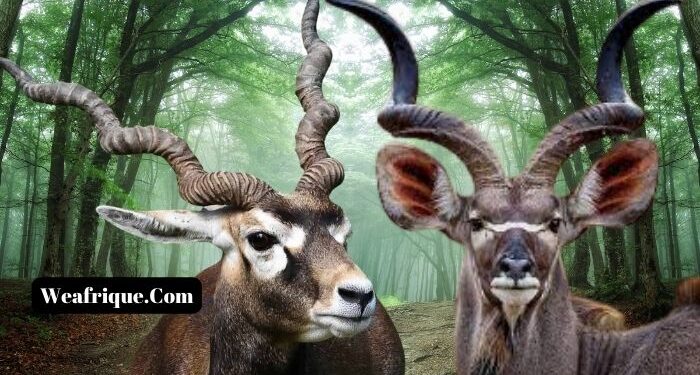With some of the most captivating sun-baked savannas and lush rainforests, it’s no surprise that Africa is called the land of diversity. One of the most captivating aspects of this ecosystem is the presence of animals who are adorned with not just remarkable structures but enchanting horns.
From the springbok to the impala and the gemsbok, these animals live in a world of their own, and above the fancy of their horns, they also serve the purpose of defense, dominance, and display.
15 African Creatures with Unique Horns
1. Giraffe
The giraffe is the tallest land animal in the world and they can be found in several African geographic regions. It is also one of the most famous African animals with horns. They are often called distinctive ossicones – bony horns fused with the skull. However, they are not true horns, but their sheer size which is up to 4 feet is remarkable.
The males use their horns in “necking” battles and winging their heads to establish dominance while the females do.
2. Gemsbok (Oryx gazella)
The gemsbok antelope is mostly found in the desert area of Southern Africa and stands out for its long, straight horns which are mostly elegantly curved inwards. These horns usually grow to about 85 centimeters and the males tend to have thicker horns while the females have longer and thinner horns.
Mostly their horns are weapons used for both defense and sparring. However, the males engage in ritualized fights for breeding rights.
3. Greater Kudu
The greater kudu is not just one of the tallest antelopes in the world but one with the most magnificent horns in Africa. They stand up to 1.2 meters at the shoulder and can weigh up to 315 kg. Their horns are often large, spiraling in structures, and have ridges and grooves with each twist unique from the other.
Males use them for display, attracting females and intimidating rivals. In addition to this, their horns can be crafted into musical instruments and can be sometimes used as a shofar in Jewish ceremonies.
4. Springbok
The springbok which is also known as the springbuck is another animal with horns. Aside from their agile and playful nature, they are also one of the most enchanting antelopes. They have a white face with dark stripes that extends from its mouth to the eyes. This is complemented by a reddish-brown coat that transitions to white as it reaches the lower third of its body and ends with a white rear.
They have lyre-shaped black horns that arch backward and stand at about 14 to 20 inches. Males use them in spectacular leaping displays, showcasing their fitness to potential mates. Their horns have also inspired African art decoration.
5. Rhinos
This list will be incomplete without the iconic rhinos which are one of the most well-known animals with horns in Africa. They have become endangered species due to poaching for their prized horns. The black and white rhinoceros possess thick, imposing horns made of keratin. They often differ in size and shape.
The horns of the black rhino are rounded at the base and sometimes evenly sized which differs from the squarish shape of the white rhino with one large horn and small horn. Rhinos use their horns for self-defense, digging, and clearing vegetation.
6. Grant’s Gazelle
The Grant’s gazelle is another animal that stands out for its horn and height. There are several species of gazelle including the speak gazelle, Thomson’s gazelle, and the dama gazelle. They all possess slender, ringed horns however, the females tend to possess shorter horns than their male counterparts that are usually equipped with longer horns.
The horns are used mostly for defense, grazing, and sparring. Also, the females choose mates based on horn size and curvature.
7. Bongo Antelope
The Bongo antelope possesses spiraling, mahogany-colored horns that often command attention. The two species that exist are the lowland western bongo and the mountain eastern bongo which are considered the larger members of the antelope family.
They are shy by nature and often use their horns for display and defense. It is not only their horns and stripes that make them unique but their hearing abilities and speed of around 60 km/h when pursued by predators. The male bongo often dwells alone while the female dwells in herds.
In many African cultures, the bongo has been linked to inducing seizures in people. As such, they are often avoided by people.
Read Also: 10 Deadliest Snakes In Africa
8. Impala
This is another common African antelope which is known for their swiftness and elongated necks supported by specially adapted spines and delicate horns only found on males.
These elegant creatures are incredibly adept at balancing on their hind legs to reach even higher foliage, earning them the nickname “giraffe of the gazelle world.”
9. Eland
The Eland is called Africa’s biggest antelope and despite its big size, it is mostly called the peaceful and slowest member of the antelope family. In fact, their calm demeanor and grazing habits have earned them the nickname “the cow antelope.”
Both males and females possess short, straight horns which are used for display and occasional sparring. Interestingly, their close relationship with humans for centuries has resulted in several domesticated breeds used for milk and meat.
10. Hartebeest
From a distance, the hartebeest looks like a misshapen antelope. They possess V-shaped horns and are iconic grazers of the savanna. Both sexes possess these horns, used in dominant displays and defense.
These hardy creatures are famous for their incredible migrations, traveling vast distances in search of fresh grazing grounds, and forming massive herds that thunder across the plains.
11. Gerenuk
With its giraffe-like neck and long, slender horns, the gerenuk presents a fascinating paradox. Reaching high foliage with its neck, it uses its horns for sparring and display, highlighting the diverse ecological niches horns can occupy.
With necks stretching impossibly long, gerenuk resembles living question marks grazing on acacia leaves. Their elongated necks, supported by specially adapted spines, are adorned with delicate horns only found on males. These elegant creatures are incredibly adept at balancing on their hind legs to reach even higher foliage, earning them the nickname “giraffe of the gazelle world.”
12. Waterbuck
Found near water sources, the waterbuck has large, lyre-shaped horns with distinctive rings. Males lock horns in epic battles for dominance, creating a spectacle of strength and determination.
Thriving in marshy savannas and riverine habitats, waterbucks are powerful antelope distinguished by their impressive ringed horns. Both sexes sport these curved horns, used for defense and dominance battles. Interestingly, waterbucks possess the remarkable ability to close their nostrils underwater, allowing them to graze submerged plants while keeping an eye out for predators
13. Sable Antelope
The regal sable antelope boasts impressive, forward-curving horns that can grow up to 4 feet long. These weapons are used for defense, sparring, and clearing dense vegetation, symbolizing the animal’s power and resilience.
Living a semi-aquatic life in papyrus swamps and dense vegetation, the sitatunga embodies adaptation. Their webbed hooves aid in navigating muddy terrain, while their long, slender legs allow them to walk through water. Males boast lyre-shaped horns, used for territorial disputes and attracting females. Their cryptic coloration and aquatic prowess make them masters of camouflage, hidden in plain sight within the reeds.
14. Sitatunga
Living in dense swamps and marshes, the sitatunga is a shy, semi-aquatic antelope. Its short, heavily ridged horns help it navigate through thick vegetation and are used for intraspecific competition.
Living a semi-aquatic life in papyrus swamps and dense vegetation, the sitatunga embodies adaptation. Their webbed hooves aid in navigating muddy terrain, while their long, slender legs allow them to walk through water. Males boast lyre-shaped horns, used for territorial disputes and attracting females. Their cryptic coloration and aquatic prowess make them masters of camouflage, hidden in plain sight within the reeds.
15. Scimitar-Horned Oryx
Due to excessive hunting in the wild for their horns, these animals which are also called the Sahara oryx have faced extinction since 2000. They have long, straight, slender horns that are curved backward and resemble curved scimitars. These horns are used for digging, cooling, and defense.
The scimitar-horned oryx is often found in arid environments like deserts and because of their adaptive natures, they can survive with water consumption. Unlike other animals, they do not have traditional structures and will often maintain groups of at least 70 members.




















